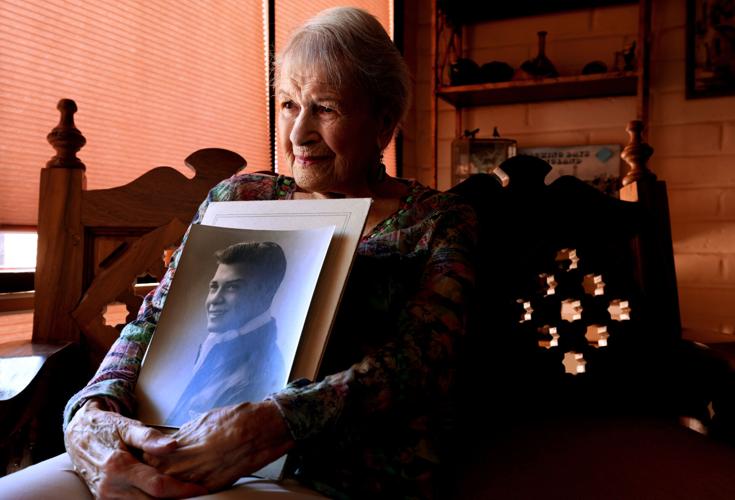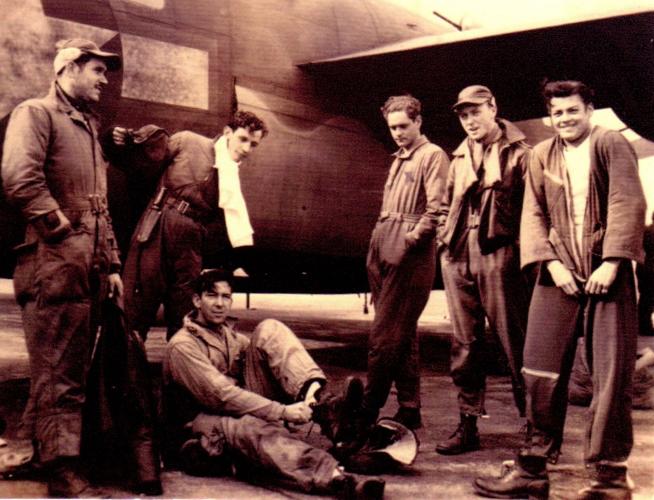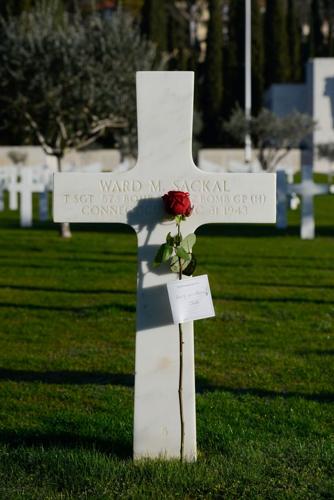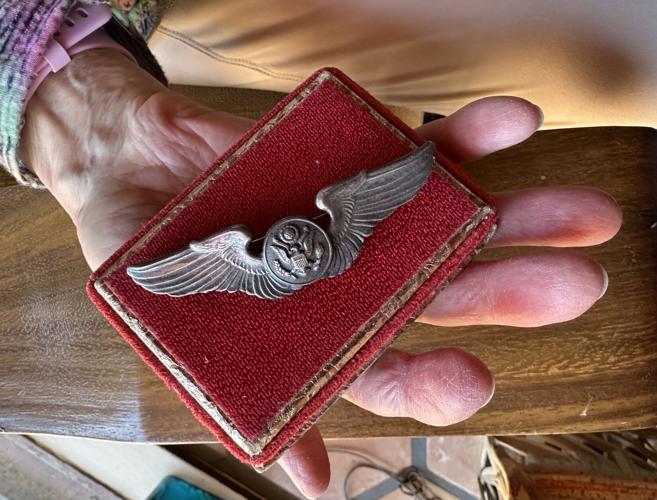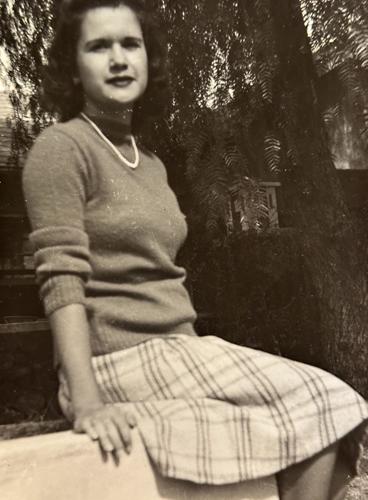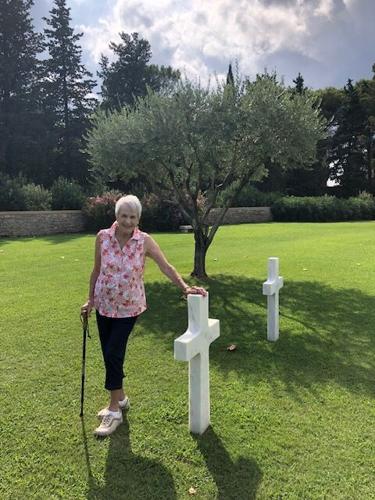Fresh flowers regularly appear on Ward Sackal’s grave in France, more than 80 years after his B-24 bomber was shot from the sky by German fighters.
Six times a year, on holidays and his birthday, a bouquet is placed in front of his marble cross at the Rhone American Cemetery. Once a month, the U.S. Army Air Forces sergeant receives a single rose with a note that reads, “Loving you always, Chris.”
Long-time Tucson resident Christine Grady Gorder said it’s the least she can do for the flyboy she considers the love of her life. She still feels that way at age 98, even though she only knew him for about two months in 1943. She still feels that way, even though he broke her heart.

A rose from Tucson resident Christine Grady Gorder decorates the grave of U.S. Army Air Forces Tech. Sgt. Ward Sackal at the Rhone American Cemetery in France in a photograph by Richard Sherman from his book “Never Home: Remembering the Military Heroes Who Never Returned.”
Early this year, Gorder published a memoir about her wartime romance. In August, she will head back to France to visit Ward’s grave for the 11th time since her first trip there in 2010.
“We were made for one another,” she said. “He’s with me every minute of every day. I’m doing all this for him.”

Christine Grady Gorder poses with a photo of Ward Sackal, circa 1942, in her home in Tucson. Gorder only knew Sackal for a few months when he was stationed at Davis-Monthan Army Air Field for training before transferring to Europe during World War II. Sackal was killed when his bomber was shot down on Dec. 31, 1943.
Love unspoken
The two met at a USO dance at Tucson’s Pioneer Hotel on Jan. 28, 1943.
He was a 19-year-old staff sergeant from Connecticut, training at Davis-Monthan Army Air Field to be a flight engineer on the B-24 Liberator.
She was a 17-year-old freshman at the University of Arizona, doing her part for the war effort by entertaining servicemen at heavily chaperoned events as a member of the USO’s Young Women’s Defense League.
They had noticed each other from across the room at previous events, Gorder said, but this was the night they finally danced and talked.
“He cut in. He was always cutting in,” she said. “Somebody would dance with me for a while, and then he would come right back and cut in again. He was determined.”
Ward walked her home from the Pioneer that night. She wrote about their meeting in her diary: “He introduced himself as Ward Sackal and, oh, I almost swooned when I looked at him. He’s just adorable — about 5-7, dark brown hair and eyes, and a mischievous smile.”

A portrait of Ward Sackal, circa 1942 and attributed to Manugian Studios, So. Norwalk, Conn.
After that, they spent as much time together as his training would allow. They would meet at dances, catch movies at the Fox or the Rialto Theatre and take long walks around downtown.
“He said, ‘I’m gonna call you every day,’ which he did. Or almost every day, when he wasn’t flying,” Gorder said.
And in between the calls and the dates, they wrote to each other.
One of Ward’s letters — in his own handwriting on Davis-Monthan letterhead — is printed in Gorder’s memoir. “I just got through talking to you and here I am writing to you,” he wrote on March 3, 1943. “It must be a very good friendship — don’t you think?”
“There was never any intimacy. We would stand outside and hug and kiss. That was it,” Gorder said. “Neither one of us ever said ‘I love you’ to the other, but we did. I’m sure we did.”
Their regular outings and near-daily communication continued all through February and March, but something changed about two weeks before Ward’s unit was scheduled to leave. Without explanation, he suddenly stopped calling her.
She was out with her friend, Martha, about a week later when she bumped into Ward and one of his crewmates. “We chatted for a while, then he looked at us and he said, ‘Take good care of her, Martha,’” Gorder remembered. “Then he said to me, ‘I’ll call you some time.’”
But he never did.
She saw him once more in passing at the Santa Rita Hotel, while she was out on a date with someone else from the bomber group.

Tech. Sgt. Ward Sackal, far right, with other members of his B-24 crew in an undated photo from 1943.
That same night, she found out that Ward and his unit would soon be leaving Tucson for their next round of training at another base.
In desperation, she called Davis-Monthan the next day and asked to speak to him. Gorder said he couldn’t or wouldn’t come to the phone, she doesn’t know which.
She never saw her sweetheart again, though it’s possible that he saw her one last time from the air as he departed.
She describes the scene in her book: On April 4, 1943, at about the time Ward’s unit was scheduled to leave, Gorder stood in her backyard and sobbed as she watched a large formation of bombers roar overhead.
“All I could do was stare in disbelief as the planes were leaving the area and slowly disappearing from sight,” she writes. “It had been a very sweet romance in very uncertain times. And so, it ended. We never said goodbye.”
Wartime Tucson
Gorder’s book is called “In the Shade of the Olive Tree,” in reference to the small tree that grows closest to Sackal’s grave.
She said she wrote it to preserve the memory of Ward and all the young men like him who put their futures on hold to fight for their country.
“In my mind, it’s a tribute to the bomber boys of World War II,” she said. “My boyfriend is the prototype in this book of all the guys. He was at New York University, and a month after Pearl Harbor he just quit school and joined (the Army).”
The book also charts Gorder’s own much longer and more circuitous journey to France.
Her family moved to Southern Arizona from Wisconsin in 1941 in search of a better climate for her sister, who was developing asthma.
Gorder — then known by her maiden name of Christine Grady — graduated from Tucson High School in the spring of 1942 and enrolled at the U of A that fall at the age of 16.
From her family’s house on Second Street near First Avenue, the university was just a short walk away. “I’d pass Pop McKale‘s house. His daughter, Marian, was one of my classmates,” Gorder recalled.
She joined the Young Women’s Defense League with her friend, Martha, as soon as she turned 17.

Chrstine Grady Gorder in 1942, when she was a freshman at the University of Arizona.
Chrstine Grady Gorder in 1942, when she was a freshman at the University of Arizona.
“There were so many servicemen, and they all wanted to have fun, go to movies and things like that,” Gorder said. “I had no trouble finding young men to socialize with, shall we say.”
The USO dances were typically held at the Pioneer, the Santa Rita Hotel or the YWCA downtown. A few times, she said, members of the defense league were bused out to Davis-Monthan for social events there that would include a tour of the flightline.
Gorder said she kept her conversations light with the servicemen she met, steering clear of topics like their late-night training flights or where those missions might eventually lead them.
“The guys never talked about what they were doing, and I never asked them any questions,” she said.
Tucson was a much different place in those days.
“Country Club was the last paved road going east,” Gorder said, and the city’s entire population of about 40,000 would have fit comfortably inside present-day Arizona Stadium.
The sidewalks downtown were crowded with men in uniform, but enrollment declined at the U of A as the war escalated. Old Main was soon converted into a Naval Training School, and Bear Down Gym became a barracks for its cadets. By 1944, the young women in the student body outnumbered the men by about 10-to-1.
Killed in action
Because of the way Ward left, Gorder said she resisted the urge to write to him once he was gone. But she couldn’t stop thinking about him.
About a year and a half after he flew out of her life, she sent an inquiry to the War Department in hopes of locating him. A terse reply arrived in her mailbox a few weeks later: Ward and eight of his fellow crew members had been killed in action in Europe.
“I was devastated,” she said.
Gorder tracked down an address for Ward’s parents and wrote them a letter to tell them how much their son had meant to her. Ward’s mother replied with a professional portrait of him in his uniform, right after he earned his wings.
At the time, it was the only picture Gorder had of him.
She ended up graduating from the U of A with a degree in Spanish in the spring of 1946, after spending the previous summer studying at a university in Mexico City.
Her dream was to work in Latin America one day, so she enrolled at a special school in New York City that offered accelerated courses in Spanish for business and technical applications. While Gorder was there, Ward’s mother came down to visit her from Connecticut. The two women spent the day together touring the city.
“Then, when I took her back to the train station, she kissed me and she said, ‘Now I know why my son liked you,’” Gorder said.
They would continue to exchange letters once a year or so, usually around the holidays. Their correspondence lasted until Ward’s mother died in the late 1960s.
After New York, Gorder parlayed her advanced language skills into a job with the newly formed Central Intelligence Agency, which sent her to Havana in 1949 and then to Ecuador in the early 1950s.
“At age 21, I had top secret security clearance,” she said with a grin.
She later married a Marine guard from the U.S. embassy in Ecuador and left the CIA after 10 years to start a family.
That path eventually landed her back in Tucson, where she raised two sons, got divorced, and embarked on a second career as an English-as-a-second-language instructor at the U of A.
In 1977, she reconnected with a man she had dated when she was a teenager in Wisconsin, and the two were married the following year. She said she and her second husband, Lyle Gorder, spent more than 25 good years together before his death in 2005.
Footlocker fall
Ward Sackal landed back in her life on Flag Day, June 14, 2009.
Gorder said she was going through an old footlocker filled with keepsakes at her east-side home, when she came across a stationery box with little red roses on it. Inside she found the only letter she still had from her handsome young sergeant: the one he sent on Davis-Monthan stationary on March 3, 1943.
The footlocker also contained the portrait of Ward that his mother had sent and a pair of his flight wings, still in the red-and-gold jewelry box he slipped into Gorder’s pocket one night while they danced.

Christine Grady Gorder holds the flight wings she said were given to her by U.S. Army Air Forces Tech. Sgt. Ward Sackal while he was training in Tucson in 1943. He was killed during a bombing raid over Nazi-occupied France on Dec. 31, 1943, when his B-24 Liberator was shot down by German fighters.
“I opened up that trunk and I saw that letter, and I just about went to pieces,” she said. “I think that is when the love story started. That is when I fell in love with him.”
With those feelings came a powerful need to know more about what had happened to him.
Some internet sleuthing eventually led her to Ward’s niece, Ellen, who was born long after her uncle’s death but still had some family lore to share about the young man.
Gorder also stumbled across the website of an association dedicated to Ward’s unit, the 392nd Bomb Group. There, she sifted through details about Ward’s final mission and connected with some of the researchers who had compiled the information.
That’s how she discovered where her beloved was buried: an American cemetery in the south of France, about an hour’s drive west of Cannes and about 450 miles east of where his B-24 crashed near Bordeaux.
Gorder learned that Ward and the rest of the 392nd were deployed to England in August of 1943. He survived 12 combat missions before he was killed during a raid on a Luftwaffe airfield near St. Jean D’Angely, France, on Dec. 31, 1943.
“When I found out what had happened to him, I decided I’m going there,” she said. “Not that I wanted to go to a cemetery, but that’s where he was. I wanted to go where he was.”
She made her first trip in June of 2010, with an itinerary that included a visit to Ward’s gravesite and a tour of the village where his bomber went down.
“One year to the day after I opened the trunk, I was at the site where he was killed,” Gorder said.
A street in Montlieu-la-Garde has been named “Rue du 31 Décembre 1943” in honor of the fallen crew, and a monument was dedicated there in 1947, inscribed with their names and that of a local villager who died when the burning wreckage struck her house.
Gorder said the town still holds a special church service and a ceremony every year on the anniversary of the crash to remember the young men from America who died fighting to liberate their country.
“People in France are so appreciative,” she said. “They’re so grateful to this day.”
Resting place
After that first trip, Gorder’s visits to Ward’s grave became an annual pilgrimage. She went every year until 2020, when COVID-19 canceled her plans.
This will be her first time back since the pandemic, and she knows it won’t be easy. She needs a walker or a wheelchair to get around these days.
“I’ve gotten so old,” said Gorder, who turns 99 on Veterans Day in November. “I mean, at 93 I was still able to dance in the street at midnight. Now I’ll sit in the street.”
This year’s trip was scheduled to coincide with the 80th anniversary of Operation Dragoon, the Allied invasion of southern France on Aug. 14, 1944. Gorder said she has been invited to sit with “the brass” at a ceremony that is being held that day near Saint-Tropez.
Then on Aug. 19, the Rhone American Cemetery will mark its establishment 80 years ago, mostly as a burial ground for American servicemen killed in what has been called “the other D-Day in France.” Gorder hopes to be there for that anniversary, too.
When she gets to Ward’s grave, she plans to do what she always does: read aloud from a letter she wrote to him before her first visit in 2010.

Tucsonan Christine Grady Gorder in 2018, during a visit to the grave in France of her wartime boyfriend, Ward Sackal, who she met in Tucson in 1943, about 11 months before his bomber was shot down over Europe. This photo is featured on the cover of her memoir, published earlier this year.
She also likes to strike up conversations with other cemetery visitors.
“I’ll say, ‘Oh, this was my boyfriend.’ I just want to get as many people as possible to know about him,” she said.
It’s an unusual thing to say about someone who died a lifetime ago, but Gorder insists she has never felt such powerful emotions for anyone — not even the men to whom she was married.
Ever since she opened that footlocker in 2009, she said, she can’t stop thinking about Ward. She frequently talks to him as she goes about her day, and she cries for him a lot, too.
Her love for him now is deeper somehow than it was even when they were together all those decades ago, she said.
Those feelings are what drove her to start buying flowers for his grave about 10 years ago. She said it was really expensive at first, but she eventually found a good local florist in France who handles the arrangements for her.
In addition to a rose every month, she said, Ward gets “big, beautiful bouquets” on Valentine’s Day, Memorial Day, his birthday in October, Veterans Day, Christmas and New Year’s Eve.
“I don’t know what’s going to happen when I pass on,” she said. “I’ll have to talk to the florist, maybe make some arrangement far out for a rose or something. I’d like to do that.”
Gorder isn’t sure how many more of these yearly trips to see Ward she has left in her, but she plans to keep going as long as her body and her travel documents are still in working order.
Unfortunately, she said, her passport is only good until she turns 100.
The Rhone American Cemetery, near the foothills of the Alps in southern France, is the final resting place for more than 850 American service members who died in World War II.


